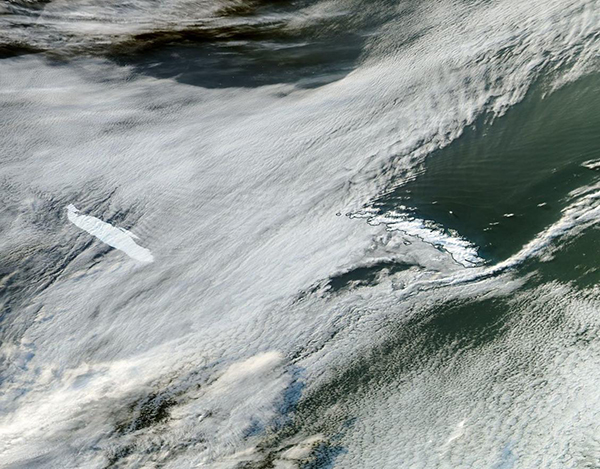Images
May 13, 2023 - Iceberg A-76D Drifting near South Georgia Island
Tweet
On May 8, 2023, the Moderate Resolution Imaging Spectroradiometer on NASA's Aqua satellite acquired a true-color image of a new-born iceberg. The long, thin berg, named Iceberg A-76D floats under cloud cover and west of South Georgia Island. Both the berg and the island appear to have similar shapes and size.
The narrow A-76D is the fourth piece to break off of an enormous iceberg which calved from the western side of the Ronne Ice Shelf, in the Weddell Sea in May 2021. At the time it calved, that iceberg (called A-76) was estimated to span about 4,320 square kilometers (1,668 square miles), which made it slightly larger than the Spanish Island of Majorca. Within a month, the monster berg lost its claim to be the largest iceberg on Earth when it broke into 3 large pieces.
The largest of those pieces, Iceberg A-76A has been drifting slowly northward. It was spotted in the Drake Passage, about 2,000 km (1,200 miles) north of where it was calved, in October 2022. The Drake Passage is a turbulent body of water between South America’s Cape Horn and Antarctica’s South Shetland Islands. Icebergs often drift into the Drake Passage, thanks to the powerful Antarctic Circumpolar Current funneling into it, and then can whip northward toward the equator and quickly melt in the warming waters.
In late April 2023, Iceberg A-76A was spotted drifting in the Northern Weddell Sea, but it had broken apart to create a new-born berg. On April 29 the U.S. National Ice Center (USNIC) confirmed that iceberg A-76D calved from iceberg A-76A in the northern Weddell Sea. A report of that calving, along with a MODIS image showing the freshly-split sliver of A-76D along with the parent berg can be viewed here.
Image Facts
Satellite:
Aqua
Date Acquired: 5/8/2023
Resolutions:
1km (198.8 KB), 500m (720.8 KB), 250m (2.3 MB)
Bands Used: 1,4,3
Image Credit:
MODIS Land Rapid Response Team, NASA GSFC
Tweet
On May 8, 2023, the Moderate Resolution Imaging Spectroradiometer on NASA's Aqua satellite acquired a true-color image of a new-born iceberg. The long, thin berg, named Iceberg A-76D floats under cloud cover and west of South Georgia Island. Both the berg and the island appear to have similar shapes and size.
The narrow A-76D is the fourth piece to break off of an enormous iceberg which calved from the western side of the Ronne Ice Shelf, in the Weddell Sea in May 2021. At the time it calved, that iceberg (called A-76) was estimated to span about 4,320 square kilometers (1,668 square miles), which made it slightly larger than the Spanish Island of Majorca. Within a month, the monster berg lost its claim to be the largest iceberg on Earth when it broke into 3 large pieces.
The largest of those pieces, Iceberg A-76A has been drifting slowly northward. It was spotted in the Drake Passage, about 2,000 km (1,200 miles) north of where it was calved, in October 2022. The Drake Passage is a turbulent body of water between South America’s Cape Horn and Antarctica’s South Shetland Islands. Icebergs often drift into the Drake Passage, thanks to the powerful Antarctic Circumpolar Current funneling into it, and then can whip northward toward the equator and quickly melt in the warming waters.
In late April 2023, Iceberg A-76A was spotted drifting in the Northern Weddell Sea, but it had broken apart to create a new-born berg. On April 29 the U.S. National Ice Center (USNIC) confirmed that iceberg A-76D calved from iceberg A-76A in the northern Weddell Sea. A report of that calving, along with a MODIS image showing the freshly-split sliver of A-76D along with the parent berg can be viewed here.
Image Facts
Satellite:
Aqua
Date Acquired: 5/8/2023
Resolutions:
1km (198.8 KB), 500m (720.8 KB), 250m (2.3 MB)
Bands Used: 1,4,3
Image Credit:
MODIS Land Rapid Response Team, NASA GSFC




